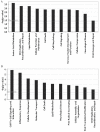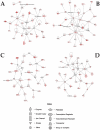Microarray analysis on human neuroblastoma cells exposed to aluminum, β(1-42)-amyloid or the β(1-42)-amyloid aluminum complex
- PMID: 21298039
- PMCID: PMC3029275
- DOI: 10.1371/journal.pone.0015965
Microarray analysis on human neuroblastoma cells exposed to aluminum, β(1-42)-amyloid or the β(1-42)-amyloid aluminum complex
Abstract
Background: A typical pathological feature of Alzheimer's disease (AD) is the appearance in the brain of senile plaques made up of β-amyloid (Aβ) and neurofibrillary tangles. AD is also associated with an abnormal accumulation of some metal ions, and we have recently shown that one of these, aluminum (Al), plays a relevant role in affecting Aβ aggregation and neurotoxicity.
Methodology: In this study, employing a microarray analysis of 35,129 genes, we investigated the effects induced by the exposure to the Aβ(1-42)-Al (Aβ-Al) complex on the gene expression profile of the neuronal-like cell line, SH-SY5Y.
Principal findings: The microarray assay indicated that, compared to Aβ or Al alone, exposure to Aβ-Al complex produced selective changes in gene expression. Some of the genes selectively over or underexpressed are directly related to AD. A further evaluation performed with Ingenuity Pathway analysis revealed that these genes are nodes of networks and pathways that are involved in the modulation of Ca(2+) homeostasis as well as in the regulation of glutamatergic transmission and synaptic plasticity.
Conclusions and significance: Aβ-Al appears to be largely involved in the molecular machinery that regulates neuronal as well as synaptic dysfunction and loss. Aβ-Al seems critical in modulating key AD-related pathways such as glutamatergic transmission, Ca(2+) homeostasis, oxidative stress, inflammation, and neuronal apoptosis.
Conflict of interest statement
Figures






Similar articles
-
Oligomeric amyloid decreases basal levels of brain-derived neurotrophic factor (BDNF) mRNA via specific downregulation of BDNF transcripts IV and V in differentiated human neuroblastoma cells.J Neurosci. 2007 Mar 7;27(10):2628-35. doi: 10.1523/JNEUROSCI.5053-06.2007. J Neurosci. 2007. PMID: 17344400 Free PMC article.
-
Dual blockade of the A1 and A2A adenosine receptor prevents amyloid beta toxicity in neuroblastoma cells exposed to aluminum chloride.Int J Biochem Cell Biol. 2014 Sep;54:122-36. doi: 10.1016/j.biocel.2014.07.009. Epub 2014 Jul 21. Int J Biochem Cell Biol. 2014. PMID: 25058312
-
Contrasting protective effects of cannabinoids against oxidative stress and amyloid-β evoked neurotoxicity in vitro.Neurotoxicology. 2012 Jan;33(1):138-46. doi: 10.1016/j.neuro.2011.12.015. Epub 2012 Jan 3. Neurotoxicology. 2012. PMID: 22233683
-
Alzheimer's disease.Subcell Biochem. 2012;65:329-52. doi: 10.1007/978-94-007-5416-4_14. Subcell Biochem. 2012. PMID: 23225010 Review.
-
Amyloid beta-peptide (1-42)-induced oxidative stress and neurotoxicity: implications for neurodegeneration in Alzheimer's disease brain. A review.Free Radic Res. 2002 Dec;36(12):1307-13. doi: 10.1080/1071576021000049890. Free Radic Res. 2002. PMID: 12607822 Review.
Cited by
-
Gene expression and highly diluted molecules.Front Pharmacol. 2014 Nov 12;5:237. doi: 10.3389/fphar.2014.00237. eCollection 2014. Front Pharmacol. 2014. PMID: 25429268 Free PMC article. No abstract available.
-
Identification of the Role of miR-142-5p in Alzheimer's Disease by Comparative Bioinformatics and Cellular Analysis.Front Mol Neurosci. 2017 Jul 18;10:227. doi: 10.3389/fnmol.2017.00227. eCollection 2017. Front Mol Neurosci. 2017. PMID: 28769761 Free PMC article.
-
Roles of receptor-interacting protein kinase 1 in SH-SY5Y cells with beta amyloid-induced neurotoxicity.J Cell Mol Med. 2022 Mar;26(5):1434-1444. doi: 10.1111/jcmm.17095. Epub 2022 Feb 2. J Cell Mol Med. 2022. PMID: 35106914 Free PMC article.
-
Aluminum-induced entropy in biological systems: implications for neurological disease.J Toxicol. 2014;2014:491316. doi: 10.1155/2014/491316. Epub 2014 Oct 2. J Toxicol. 2014. PMID: 25349607 Free PMC article. Review.
-
Runx2 expression: A mesenchymal stem marker for cancer.Oncol Lett. 2016 Nov;12(5):4167-4172. doi: 10.3892/ol.2016.5182. Epub 2016 Sep 23. Oncol Lett. 2016. PMID: 27895787 Free PMC article.
References
-
- Lovell MA, Robertson JD, Teesdale WJ, Campbell JL, Markesbery WR. Copper, iron and zinc in Alzheimer's disease senile plaques. J Neurol Sci. 1998;158:47–52. - PubMed
-
- Good PF, Perl DP, Bierer LM, Schmeidler J. Selective accumulation of aluminum and iron in the neurofibrillary tangles of Alzheimer's disease: a laser microprobe (LAMMA) study. Ann Neurol. 1992;31:286–292. - PubMed
-
- Liu G, Huang W, Moir RD, Vanderburg CR, Lai B, et al. Metal exposure and Alzheimer's pathogenesis. J Struct Biol. 2006;155:45–51. - PubMed
-
- Sensi SL, Paoletti P, Bush AI, Sekler I. Zinc in the physiology and pathology of the CNS. Nat Rev Neurosci. 2009;10:780–791. - PubMed
-
- House E, Collingwood J, Khan A, Korchazkina O, Berthon G, et al. Aluminium, iron, zinc and copper influence the in vitro formation of amyloid fibrils of Abeta42 in a manner which may have consequences for metal chelation therapy in Alzheimer's disease. J Alzheimers Dis. 2004;6:291–301. - PubMed
Publication types
MeSH terms
Substances
LinkOut - more resources
Full Text Sources
Medical
Molecular Biology Databases
Miscellaneous

